Fedora 36 KDE Spin for a digital painting workstation: reasons and post-install guide
Table of Contents
- Intro
- Why GNU/Linux?
- Why not continuing with Kubuntu 22.04LTS?
- Why Fedora?
- Why KDE Plasma desktop environment?
- Installing Fedora KDE Spin
- Login into the X11 Session
- Color calibration
- Tablet
- Theme
- Krita for Digital-Painting
- The "GNU/Linux Creative Suite"
- Video Channel and Streaming
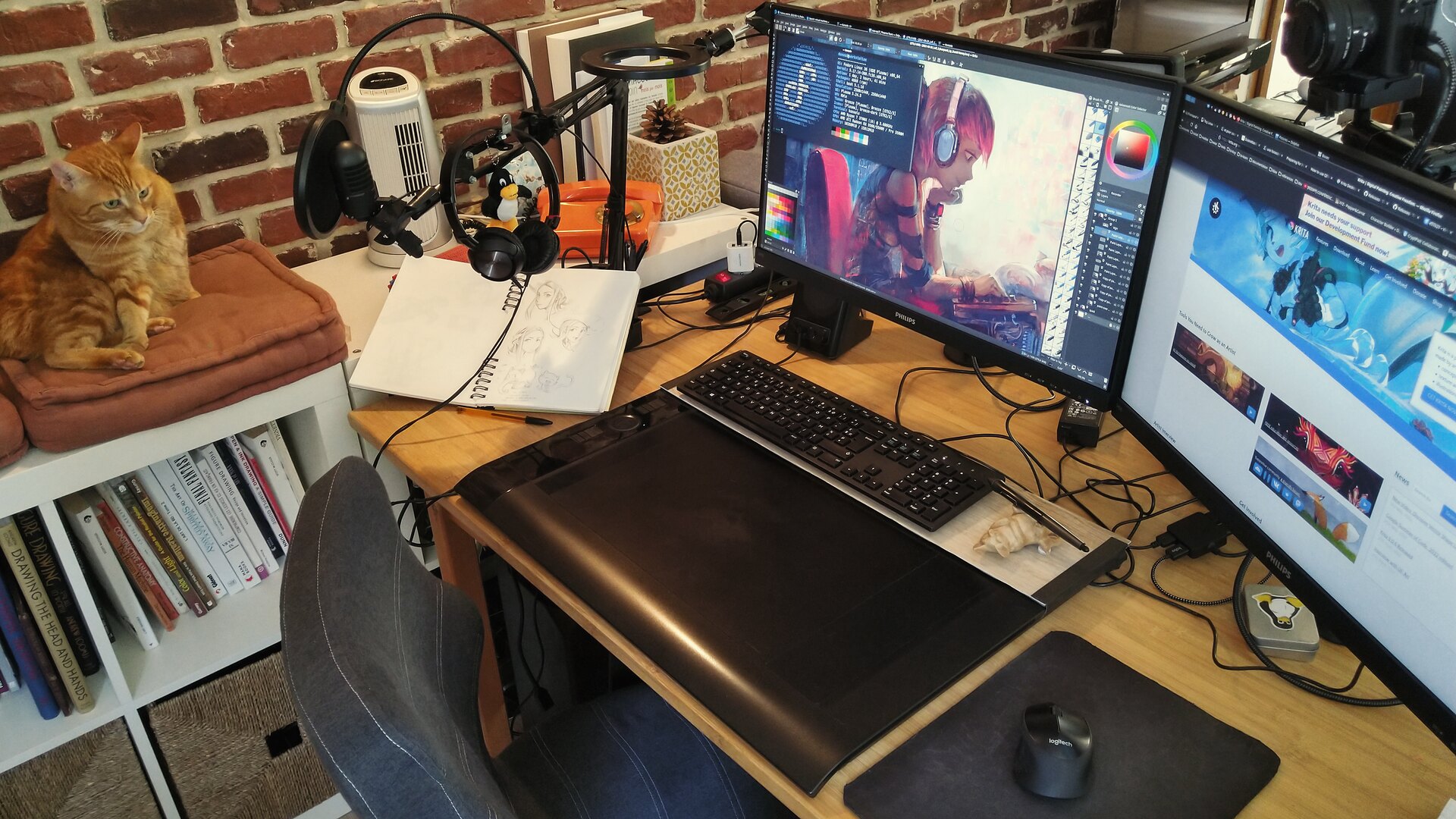
A photo of my catstation workstation.
Updates:
- 2022-06-19: Erratum about DisplayCAL, Color Calibration chapter.
Intro
I'm once again sharing an install guide (I started making them on my blog eleven years ago). I write this for other digital-painters wanting to switch to a GNU/Linux workstation with all comfort.
Reasons
I'll explain here my main reasons for advising and recommending this GNU/Linux distro for a digital-painting workstation in 2022.
Why GNU/Linux?
My main big reasons to use a GNU/Linux open-source system evolved a bit from the origins, it is now split into four reasons:
- Independence (no one have a control on what I watch, what I use and how I use it).
- Technology (performance, scripting, standards).
- Transparency (open-source: you can investigate any parts).
- Control of my data and privacy (I don't want companies to influence my behavior threw targeted adv).
Why not continuing with Kubuntu 22.04LTS?
My last guide was about Kubuntu 20.04LTS, and I used it during two years. Two years!...that was splendid. So, with that success in mind, I imagined it would be a no-brainer to continue with the newest Kubuntu to the date: 22.04LTS.
Unfortunately, I tested 22.04LTS and I disliked it. It has a slower Firefox packaged only as Snap. Also, applications installed with the command line "apt install" could come as Deb package, or as Snap package without knowing it ahead (and Snap version often comes with additional bugs). To top it all off, a Snap directory was even hard-coded in my /home directory.
Of course, all of that pre-existed 22.04 in a lighter form, and it was easier to dodge or uninstall it. With 22.04, I felt Canonical wanted really to push Snap on me and I couldn't see any technical advantage to impose to myself this technology. Especially when the GNU/Linux ecosystem has many other choices.
Why Fedora?
It's not a rolling GNU/Linux distribution. You won't get the surprise of having software changing all the time. You'll get a collection of packages frozen for around half a year, and that's good for training your habits and setup a workflow that − you can trust − will work as intended when required.
Application updates are installed after reboot and, when updating, the software center (named "Discover" on the KDE Spin) will only download the list of packages and prompt you for a restart later. The software are then installed at the next system boot. This way, you never have libraries or software crashing in mid-air on your system during an update.
It also looks like Fedora is able upgrade between major versions without a problem. I had Fedora on a spare laptop for a while (for testing), and it managed to update itself from Fedora 35 to 36 without a single issue. Just as one swallow doesn't make a summer, I have no idea if it will be the case for future Fedora 36 to future Fedora 37 for end of 2022, but let's try.
Why KDE Plasma desktop environment?
You'll certainly see that Fedora flagship desktop environment is GNOME Desktop Environment. But I'm recommending the KDE Spin because of many reasons that will be detailed later on this article. It is mainly about more options for the tablet settings, options to setup a neutral colored theme, thumbnails for your artwork source files and easier file type association and 'open with' menu, better support for multi monitor workflow and perfect desktop integration with my core application: Krita and Kdenlive.
Install guide
Installing Fedora KDE Spin
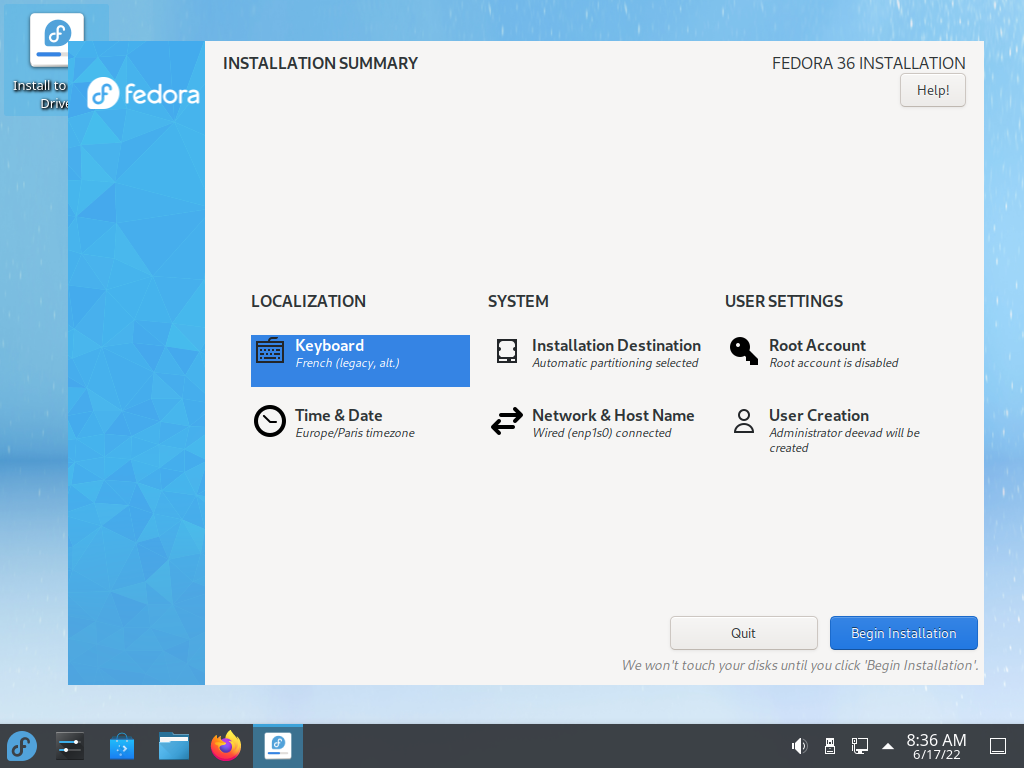
The Fedora installer in action
You'll find a free copy of the ISO image of Fedora KDE Spin on Fedora official website, just scroll down to the "Spins" box near the footer of the page, and then click on it. You'll find the ISO file for the Fedora KDE Spin here.
For the install of Fedora itself, I prefer to redirect you to the official Installation Guide documentation. I found it very well done and written for Linux, Windows and Mac user. It's more complete and detailed than everything I could write about it.
Once done, don't forget to install all updates using Discover (you'll get an icon in the system tray inviting you to do so) and reboot.
Login into the X11 Session

The X11 session option on the bottom right of the login screen.
Fedora 36 KDE Spin proposes Wayland technology for their display server by default. Unfortunately, Wayland is far to be ready for digital-painter, graphists, and artists. Many digital painting application (Krita, Mypaint) will not work well on Wayland and will contains more bugs, lags, freeze and you'll get more limited option for installing a tablet or a color profile.
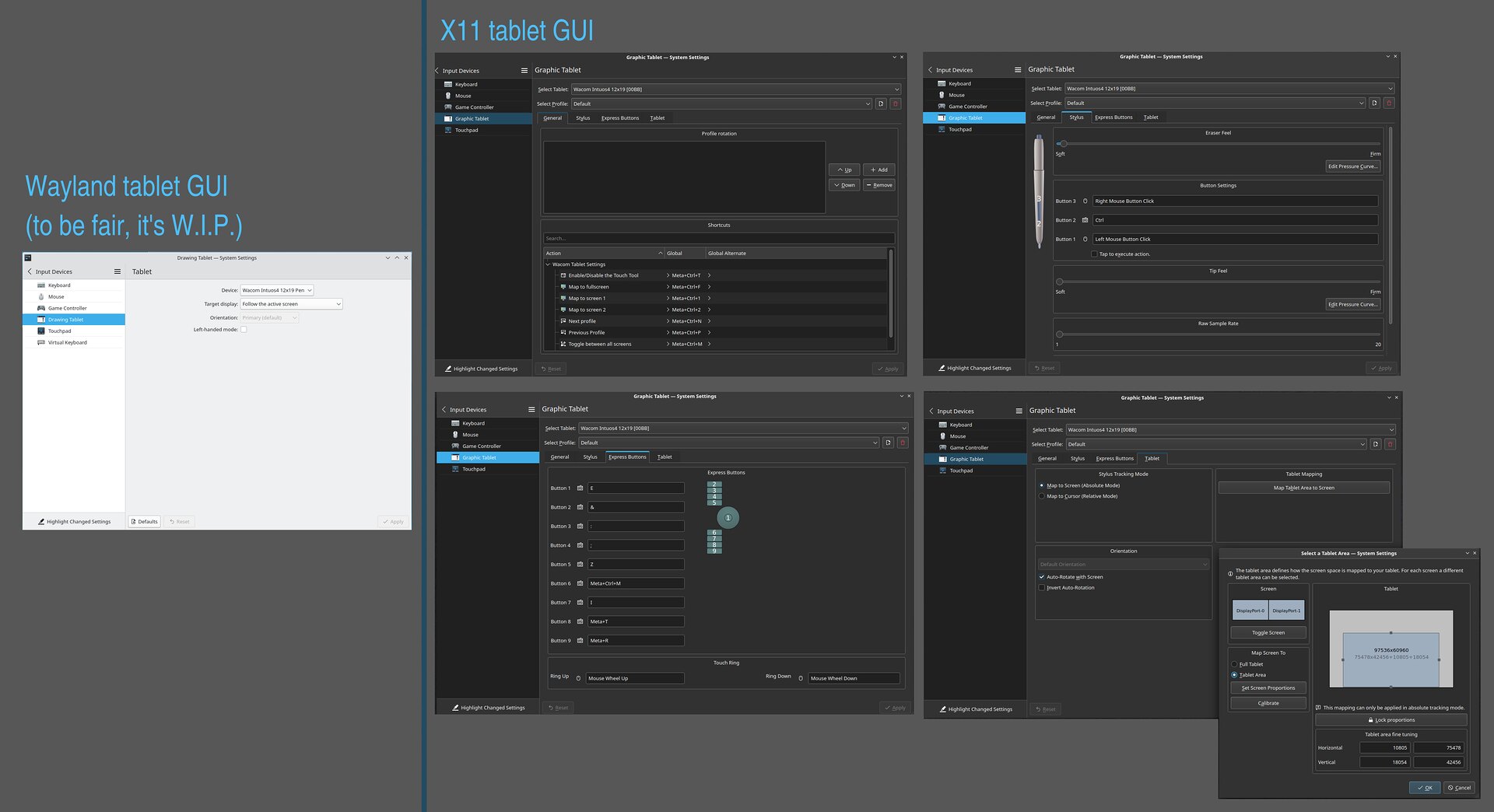
Comparison of the setup dialog for tablet on Wayland versus X11.
That's why it's preferable to login into the X11 session. On your login screen, you'll have an option to switch between the default(Wayland) and X11. Once you setup your choice, your desktop will remember the choice for the future login.
Color calibration
For any digital-painter and artist, it is important to calibrate monitors and do that monthly. But you'll see, GNU/Linux community at large don't care about this topic and still think it's a fancy optional details for picky users (and then whine about the lack of graphist or artists on the platform, lol).
So, by default, you'll have something half-working in System Settings > Color Correction. The good: this graphic user interface can apply ICC profile to your monitor. The bad: you'll see a red box mentioning "You need Gnome Color Management installed in order to calibrate device". But don't try it, this message is a an obsolete information since years and a known abandoned bug.
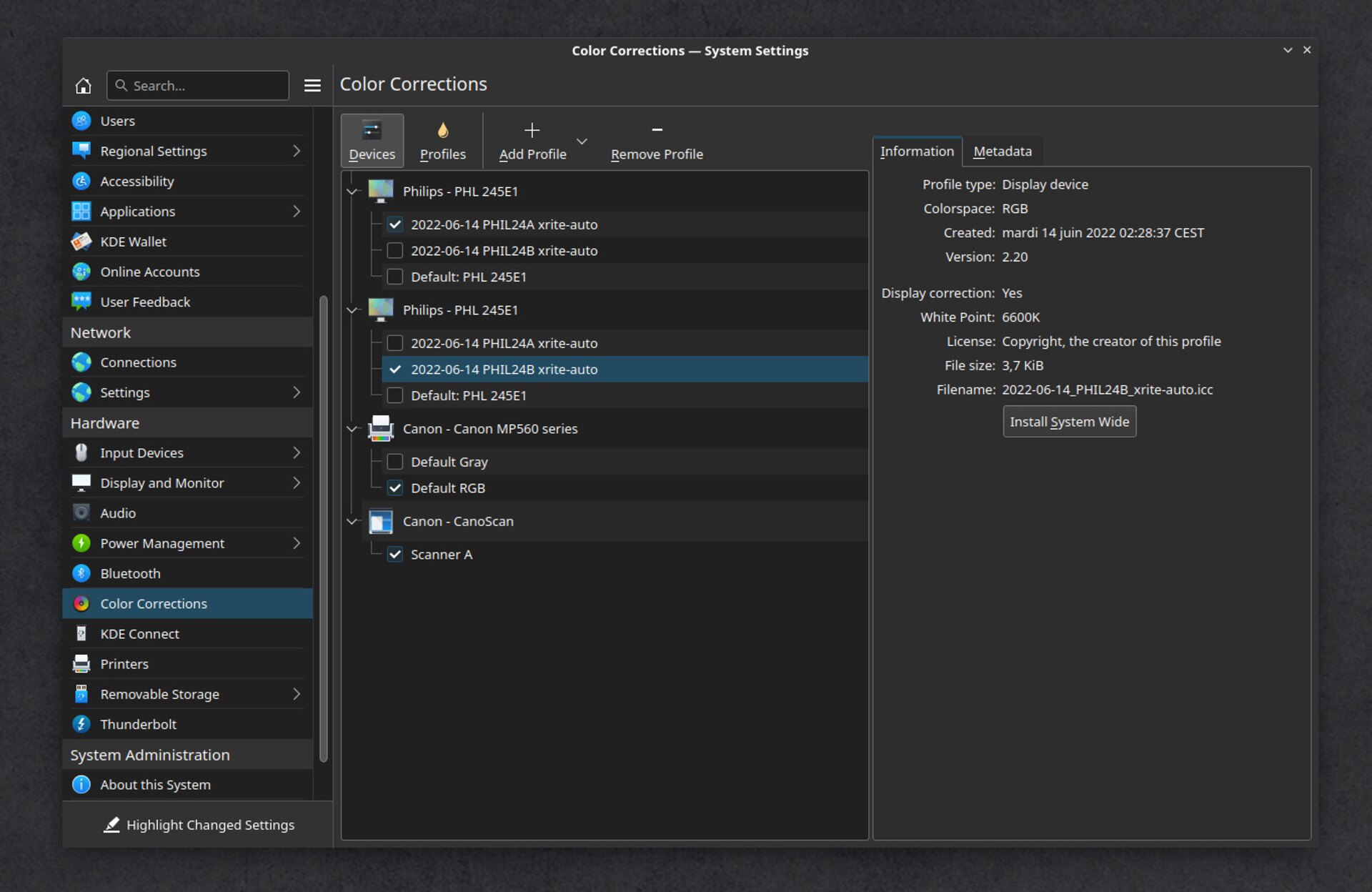
The Color Correction setting panel on Plasma.
The only graphic user interface to calibrate your monitor was is DisplayCAL but the development of this one is now abandoned since years and wont run on Fedora 36.
[2022-06-19] Erratum: thanks to comments (on the bottom of this article), I was informed you can still run DisplayCAL as a Flatpak on Fedora 36. Good news! I tested the Flatpak and it was simple to install: just download a reference file on Flathub and double-click it: Discover will manage everything else. I ran the test with my two calibrators (Pantone Huey Pro and ColorMunki Smile) on my two displays. It wasn't bug free but it did the job. I had mainly a warning windows about my local being English(US) and a crash on the first run; but the second run went smoother. DisplayCAL comes with a very interesting ICC profile viewer.
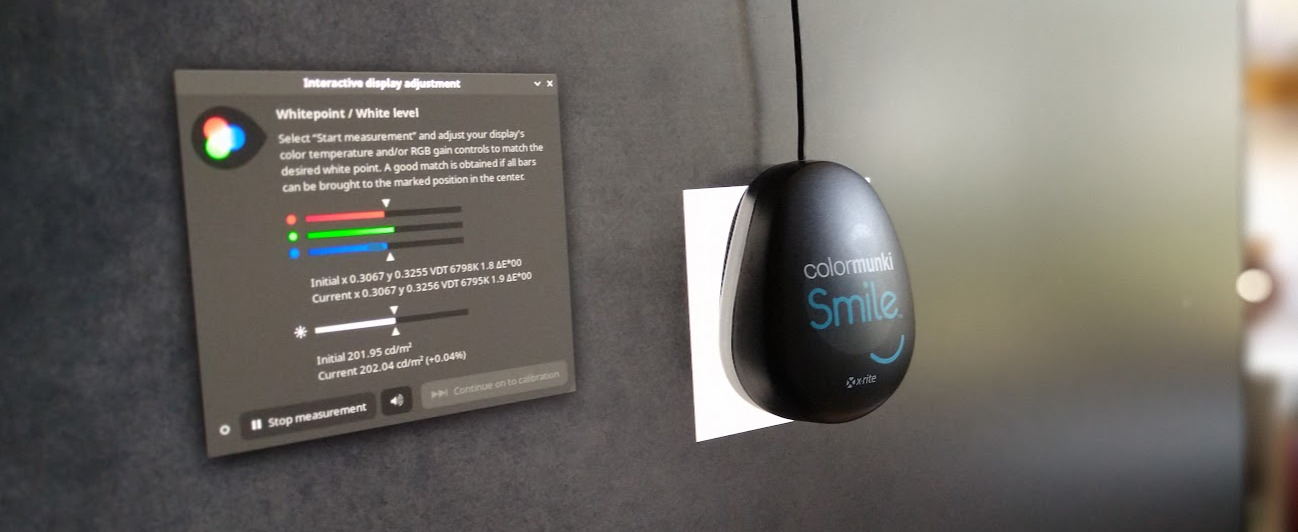
Erratum: DisplayCAL can run as a Flatpak.
Argyllcms 'dispcal' command line to the rescue
If you want to calibrate your monitor, the only solution will be to use ArgyllCMS command line at this point. Don't be affraid, it works pretty well and it is not that complex. You can launch "Konsole" and then type (or copy/paste, pasting being Ctrl+Shift+V in terminal):
sudo dnf install argyllcmsYou'll be prompted for your password (it's normal, we install something new). Connect then your calibrator on your USB port, position it on the center of your screen and paste a line like that
dispcal -d 1 -t 6500 -b 160 -g 2.2 -yl -v -o MyFilnameForMonitor1Customise it to your liking, here is a quick description of the arguments of this line you can customise:
- -d 1: refers to the display. Eg. use -d 2 for a second monitor.
- -b 160 refers to the brightness target in candela meter square, here a 160cd/m²
- -t 6500 refers to the target temperature, 6500K here.
- -g 2.2 refers to Gamma 2.2.
After done and following the calibration, you'll end up with MyFilnameForMonitor1.icc (you can customise the name here). Save it somewhere, and then you'll be able to load this profile with System Settings > Color Correction.
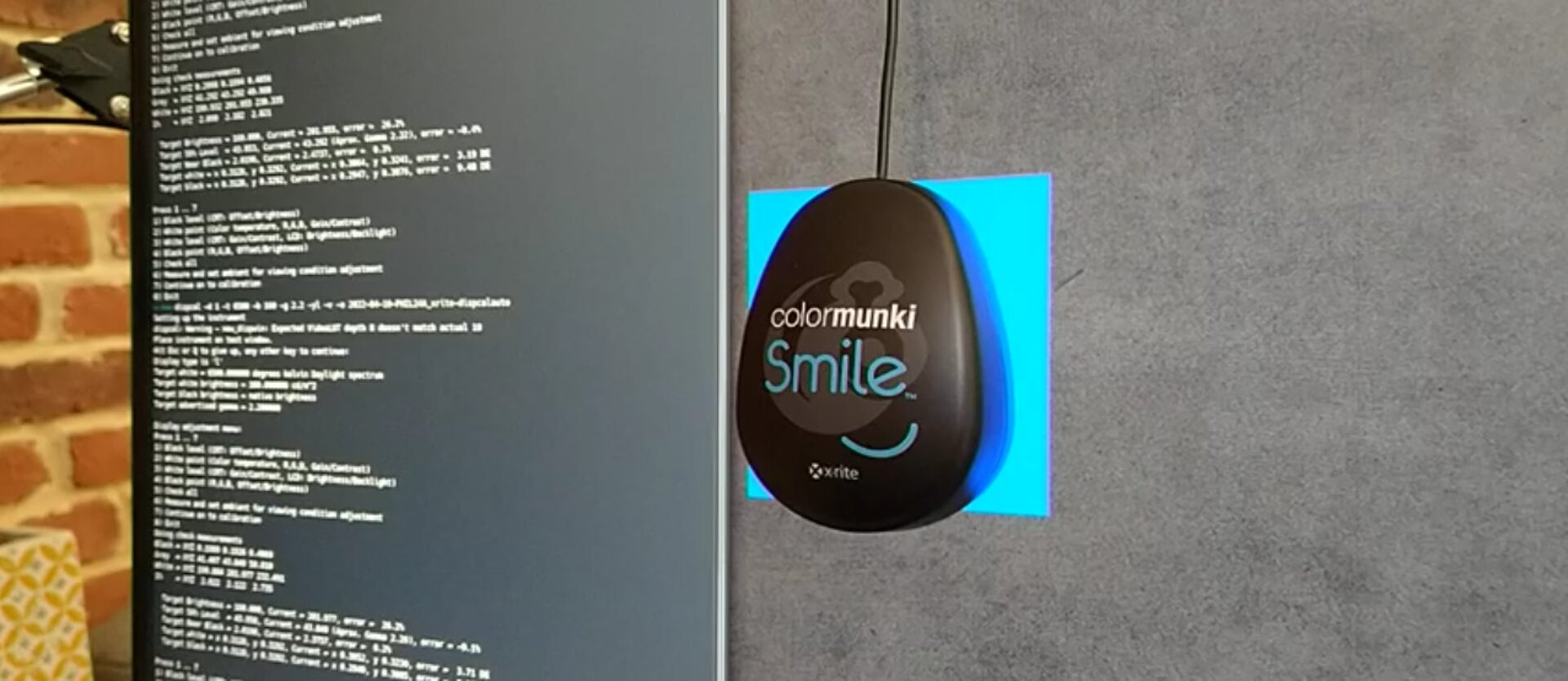
My calibrator device while a calibration using the dispcal command line utility.
Tablet
The Plasma desktop under X11 provides a complete tool to setup Wacom's tablet. You'll find different setup for the ring, you'll be able to customise all buttons and also apply a custom area on a specific monitor. You'll also have access to button to switch monitor and many other conveniences. You can install it with:
sudo dnf install kcm_wacomtabletAfter that, reboot, and you'll find later the tablet settings into System Settings > Input Devices > Drawing Tablet.
If your tablet is not a Wacom one, you'll have to search probably for specific installation guide and method. I try on the 'hardware' tag on my blog to document that for the tablet I own.
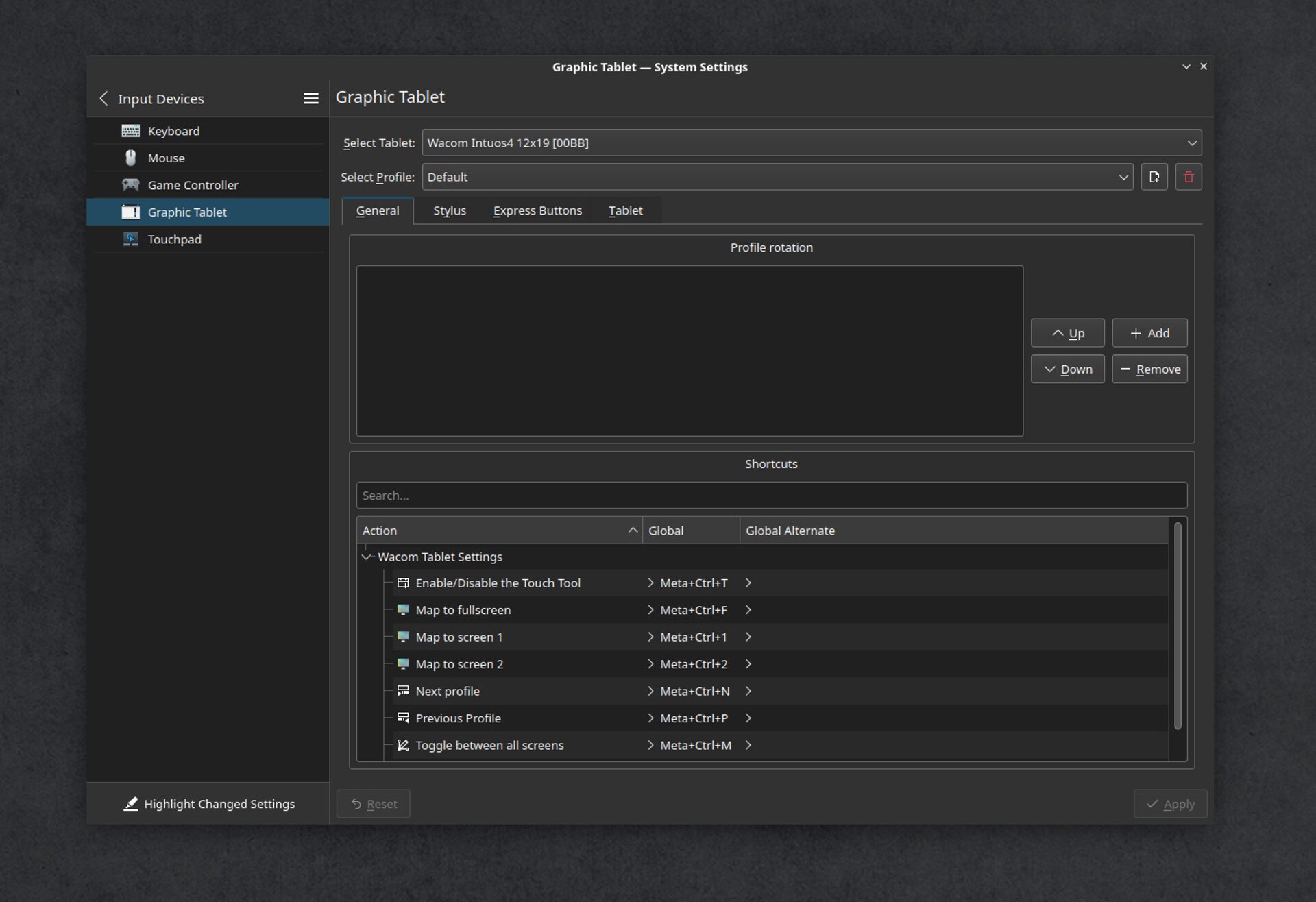
The first panel of the tablet settings, notice the profile rotation to setup multiple configurations.

The second panel about the Stylus configuration. You can even configure the Supress and Sample Rate.
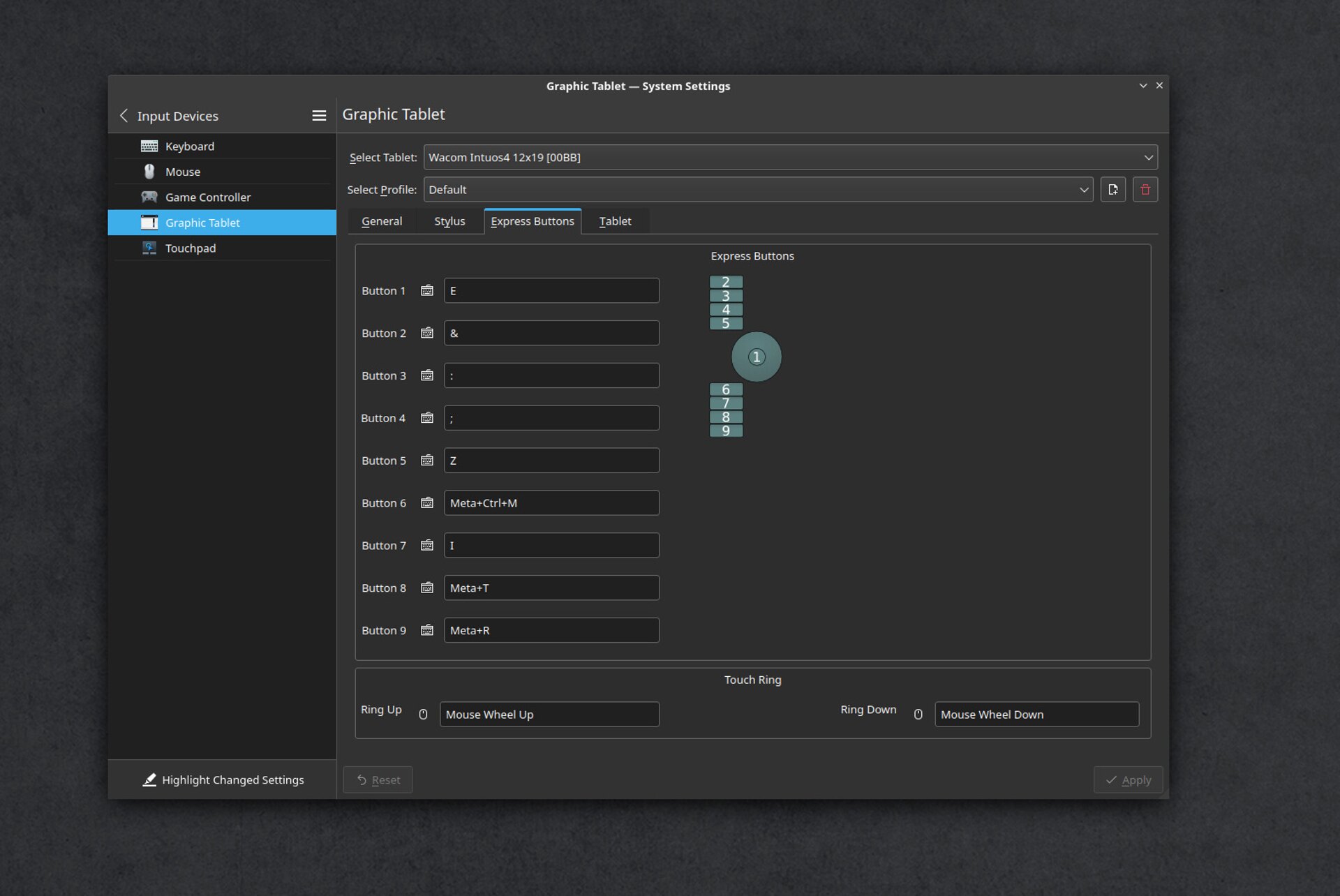
The third panel with configuration for the buttons and ring up and ring down.
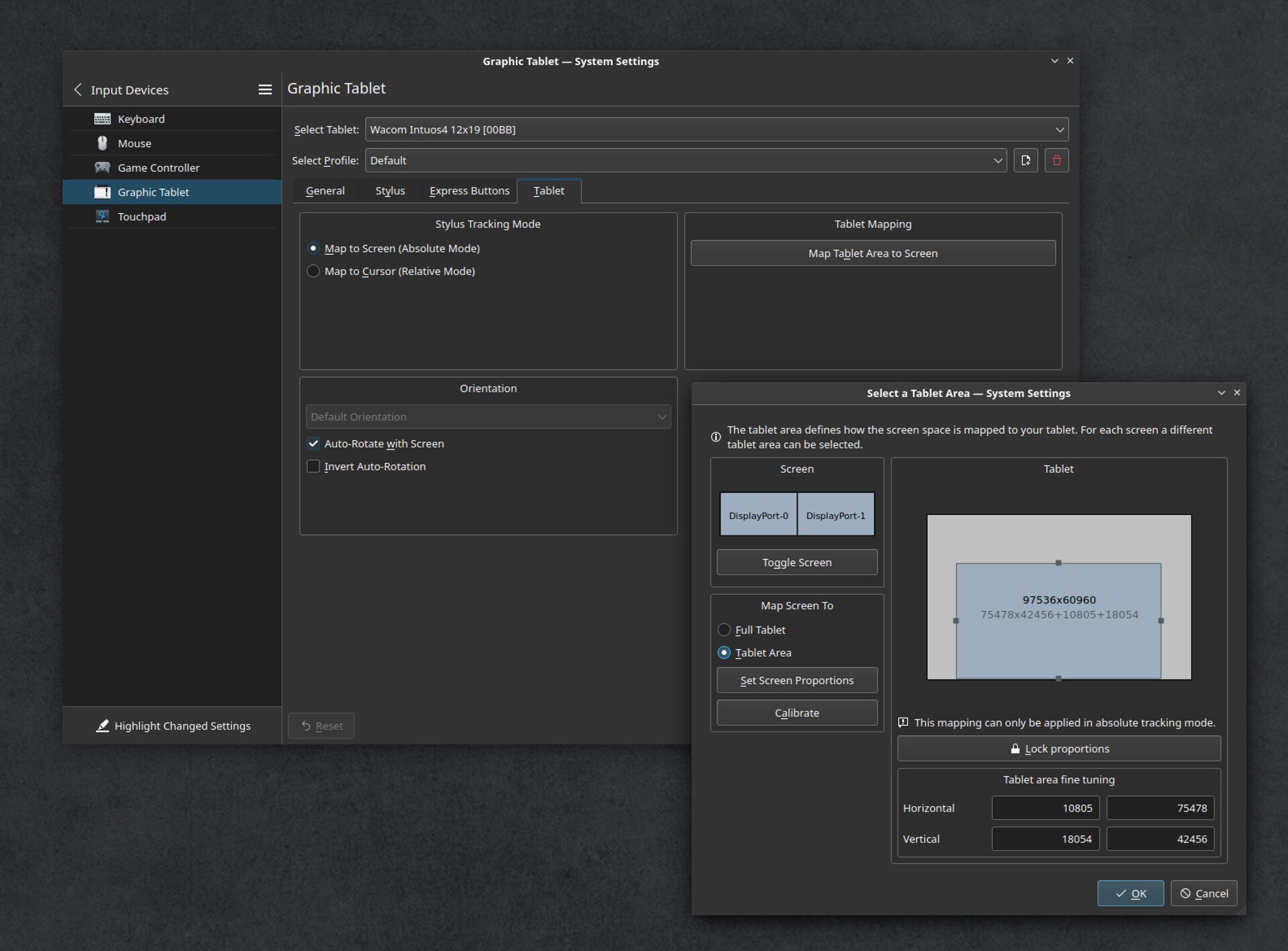
The last panel is dedicated to the mapping of the tablet: you can assign it to a display, to an area, and calibrate devices like Cintiqs.
Theme
The Plasma desktop offers many customisation for the theme. You'll find that in System Settings > Appearance > Colors many option and a button to install more Color Scheme. This theme will be reflected (if you choose so) in your KDE apps. You'll then have a perfect desktop integration for Krita, but also Kdenlive video-editor, Kate text-editor, etc...
My preference goes to neutral gray theme, they help me to get a color balance in my artwork. I wouldn't advice "slightly colored cold grey or warm grey"; these one are the worst to unbalance your reference of what can be a neutral gray. I also like theme with black top bar for windows title. Right now, I'm using "Breeze Dark Neutral" but I also like "Wonton Soup Neutral" and "Materia Equilux".
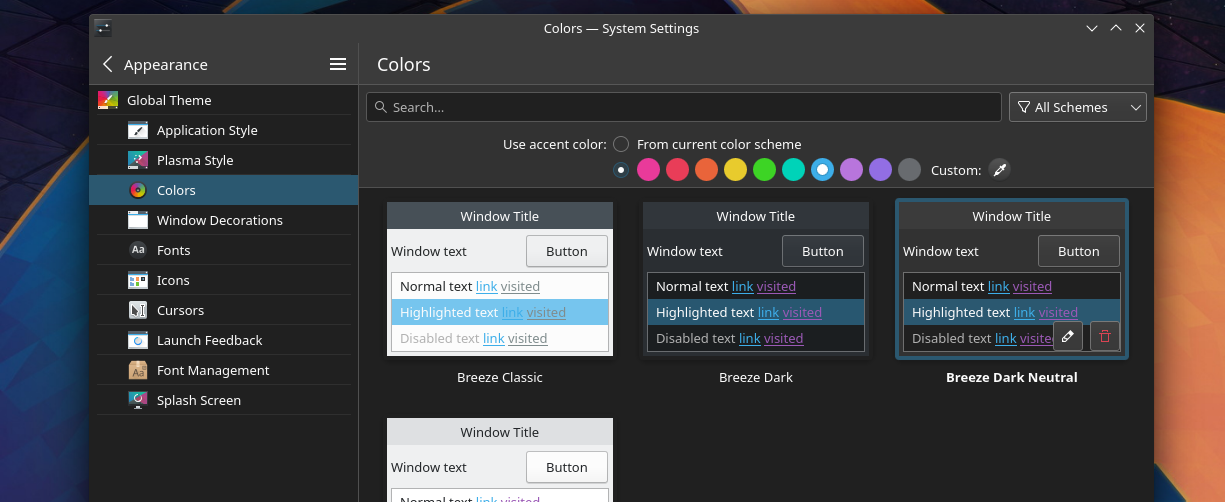
The Apperance, Colors setup in the settings.
Krita for Digital-Painting
As a digital-painter you'll probably want the latest Krita available. But if you install it via the app store (Discover), you'll only have the choice to use a version 5.0. Krita team packages a version themselves and test it. Therefore, if you want the best quality and the lesser bugs, you'll need to download the latest Appimage from krita.org.
Unfortunately, Appimage packages don't have the best and easiest system integration. That's why I'll advice you to download and install an utility named AppImageLauncher. Download the latest AppimageLauncher here (get the file finishing by x86_64.rpm). Once downloaded, click on it and Discover will install it. You can visit AppimageLauncher Setting in your main menu after that and setup where you want your Appimages stored on your directory. When it is done, you'll only need to double-click your appimage to launch them, auto-move them to your Appimages directory, and integrate them with your main menu.
You'll also get Krita kra files thumbnails by default on Fedora KDE Spin, along many other thumbnail for image format, a nice touch. You'll also be able to preview your Krita artworks with an image reader named qimgv on Discover. (not with Gwenview for this bug, not with Nomacs for this bug).

Dolphin −the file browser of Plasma− supports many thumbnailer for images format.

Dolphin supports very large thumbnails, making easier the identification of picture by their content, not only their filenames.
Once installed, you can associate qimgv with your Krita files. Find a Krita kra file, right click on it, go to Properties and in the tab General press the button Open With: Change and you'll have an interface to manage Application Preference Order. You can add qimgv to your list. I like here to get it on top, so when I double click a Krita file, I can preview it. And to edit, I need to go Right-click "Open with: Krita". I often do that for all my images format, tiff, Png, Jpg, etc...
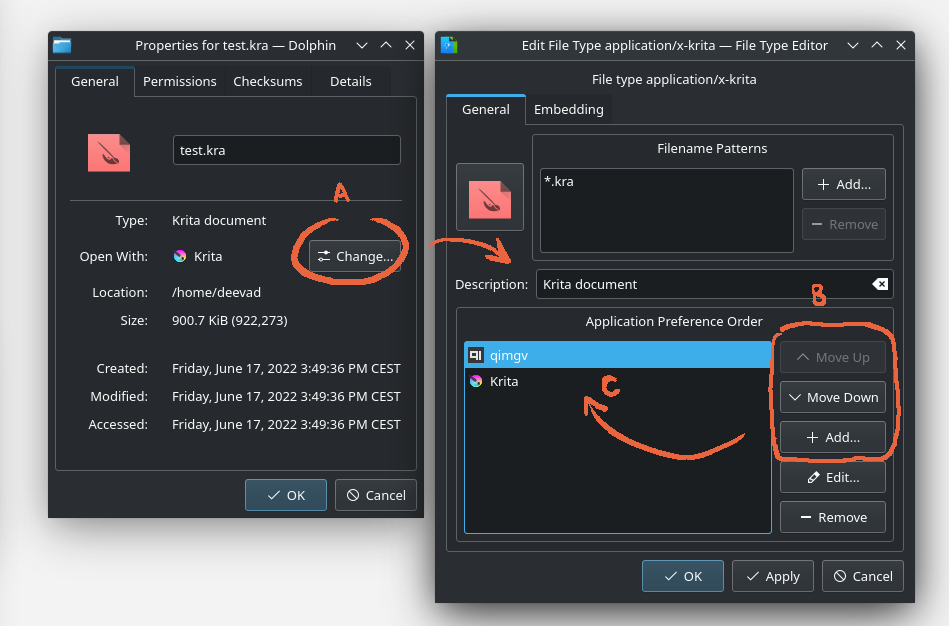
File association, a quick how-to.
The "GNU/Linux Creative Suite"
For other applications, I often just go with the version distributed by Fedora. I'm using:
- Vector drawing application: Inkscape
- 3D modeling/Rendering: Blender
- Digital Painting (alternative): Mypaint
- Image Editing: The GIMP
- Images auto stiching: Hugin Panorama Creator
- Audio Editing: Audacity
- Gif animation capture: Peek
- Desktop Publishing: Scribus
- Editing fonts: FontForge
You'll find them directly in Discover, but you can also install them all with this single command line:
sudo dnf install inkscape gimp mypaint blender hugin peek audacity scribus fontforge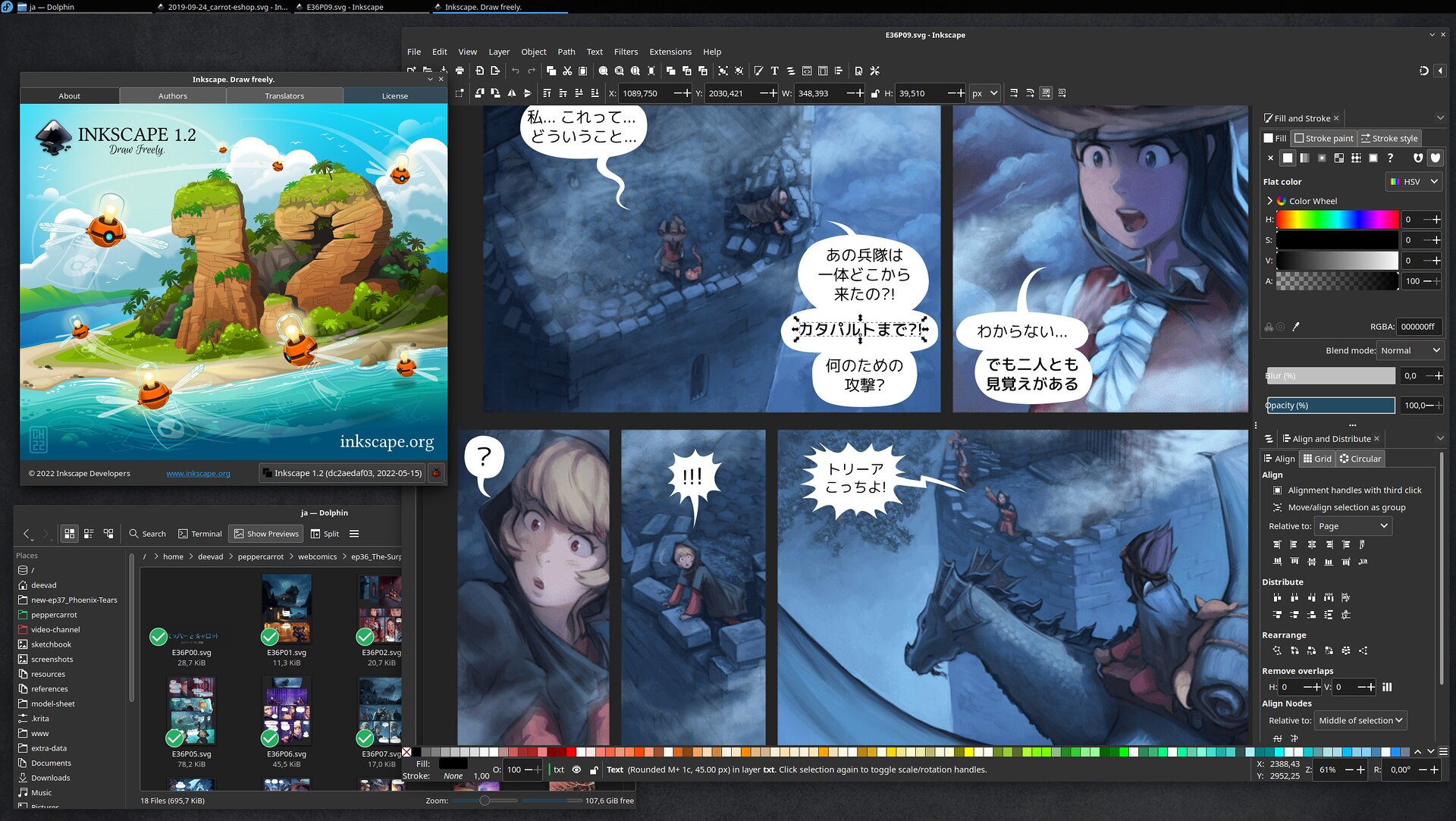
A screenshot of Inkscape while editing the Japanese version translated by Guruguru of Pepper&Carrot episode 36.
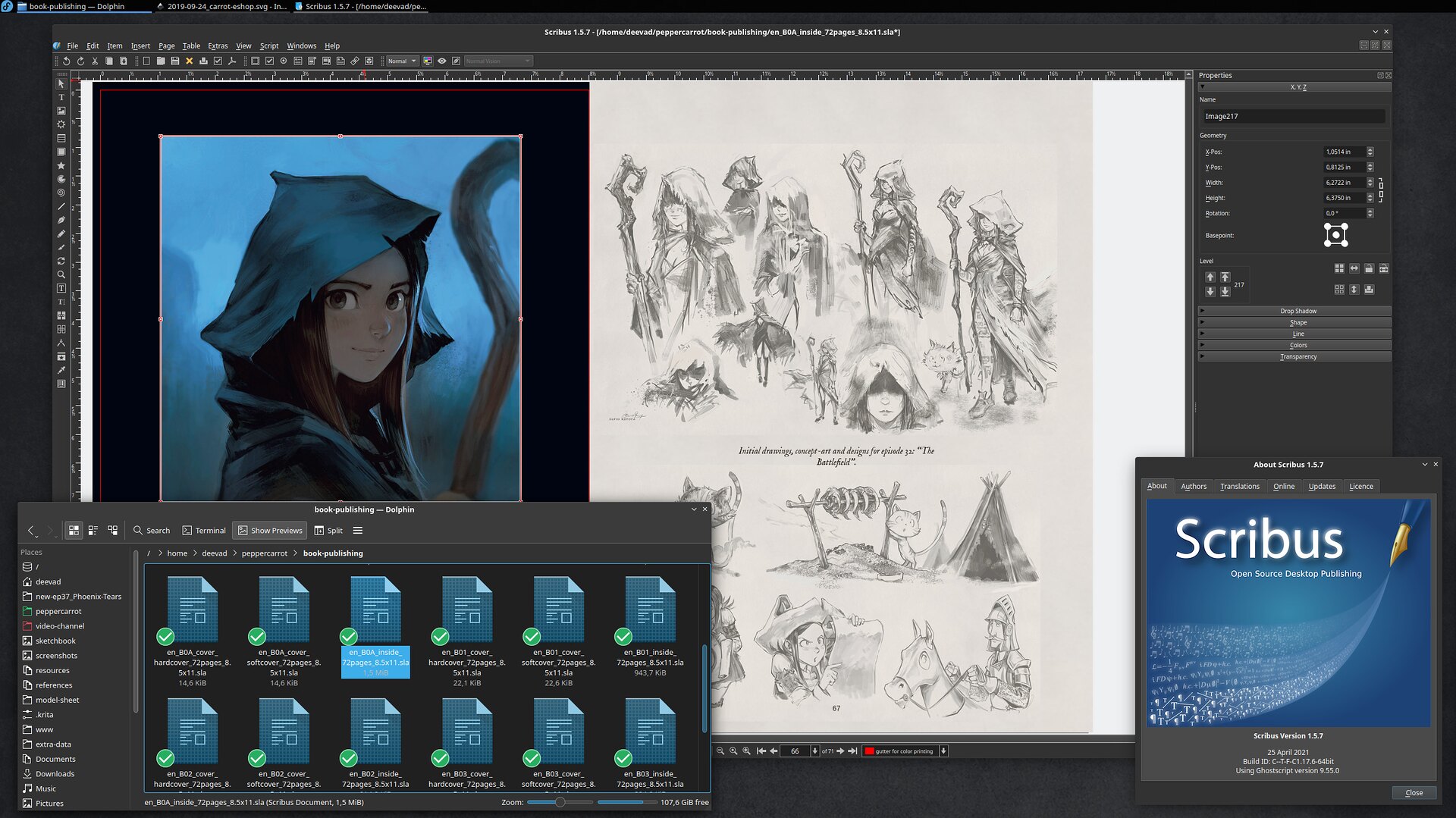
Scribus opening a double page of the Pepper&Carrot artbook.
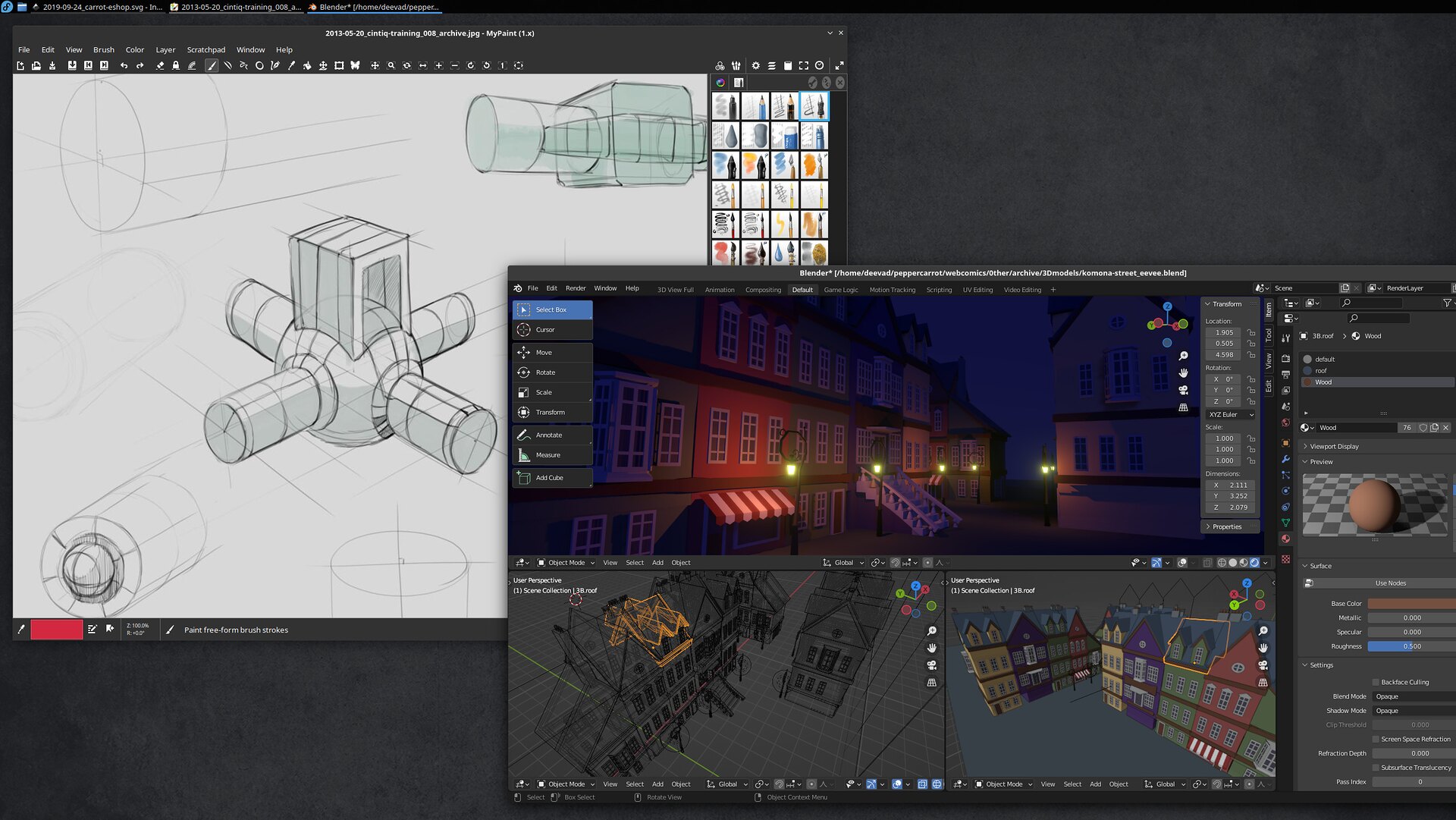
Screenshot of Mypaint and Blender 3D.

Screenshot of Audacity audio editor and Fontforge font editor.
Video Channel and Streaming
OBS Studio
OBS Studio is the best tool to record your desktop for tutorials, timelapses (often wrongly named 'Speedpaintings') and stream your desktop online. I tested various version here and they were very glitchy, I found a working package following this method using RPMFusion repository.
Kdenlive
I use Kdenlive mainly for my videos since the DVD Chaos&Evolution in 2009. I love this video-editing application. I'm using mainly here a Kdenlive Appimage. You'll find it on Kdenlive official website. You'll need to install using the same method I wrote on the paragraph about Krita. It's very easy once you already have AppimageLauncher.
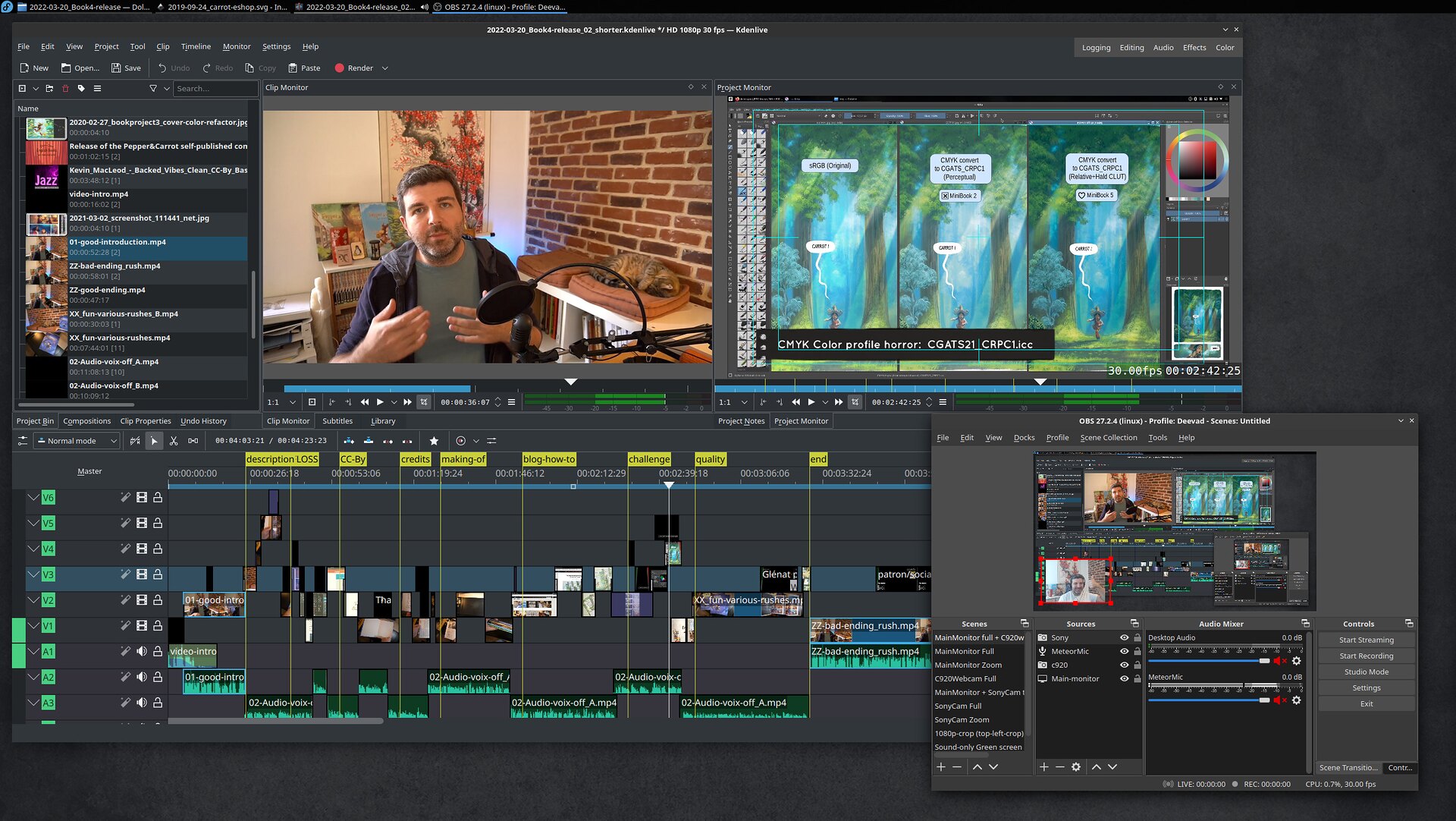
Screenshot of Kdenlive video editor and OBS Studio.
Video thumbnails
Having video thumbnails will be much more helpful to triage on disk your video take and identify your renderings. In Konsole, install:
sudo dnf install ffmpegthumbsAnd then close all your file managers windows, open a new one and go to the Settings (the burger menu on top-right) and then Configure > Configure Dolphin, General > Preview (tab) activate the check-box Video Files (ffmpegthumbs). Apply, close and voilà.
Appendices: the advanced guide
If you are curious about my full install with my Canon MP560 Printer on Fedora, My Canon Scanner Lide 220 on Fedora, all the papercuts I had, the specific workaround for my hardware and all the packages I need to run the Pepper&Carrot project: book-publishing, the translation system, my LAMP stack for the websites, etc... I made another install guide, a bit more raw with a lot more command lines and observations.
You can read it on Invent.Kde.org Snippets: fedora-36-kde-spin_peppercarrot-workstation.md
Conclusion
I hope you liked this article! Many thanks to all contributors of this fantastic Free/Libre and open-source system for creatives: Fedora contributors, all Plasma KDE contributors and all contributors of application mentioned in this article.
Also a big thank you to my patrons for supporting my experimentation, the time I take testing, bug-reporting and documenting my process.
Links and bibliography
Useful community to search information:
- The Fedora official user documentation: https://docs.fedoraproject.org/en-US/docs/
- Fedora Magazine: https://fedoramagazine.org/
- Ask Fedora: https://ask.fedoraproject.org/
- Fedora Reddit news and discussion: https://www.reddit.com/r/Fedora/
Here are article and videos that influenced me:
- Video "Fedora is the new Ubuntu - Fedora Long Term Review" by The Linux Experiment https://www.youtube.com/watch?v=D9h_0dnSGWk
- "OBS Studio and Fedora Linux: An Interview with Georges Basile Stavracas Neto" https://fedoramagazine.org/obs-studio-and-fedora-linux-an-interview-with-georges-basile-stavracas-neto/
- "How to install the latest stable Kdenlive on Fedora or Ubuntu" https://cialu.net/how-to-install-the-latest-stable-kdenlive-on-fedora-or-ubuntu/
- "How to Migrate to Fedora Linux from Ubuntu ,Beginner’s Guide" https://www.debugpoint.com/2021/04/migrate-to-fedora-from-ubuntu/
- "Sorry Arch (EndeavourOS), it's not working out any more and hello Fedora" https://www.gamingonlinux.com/2022/04/sorry-arch-its-not-working-out-any-more-and-hello-fedora/

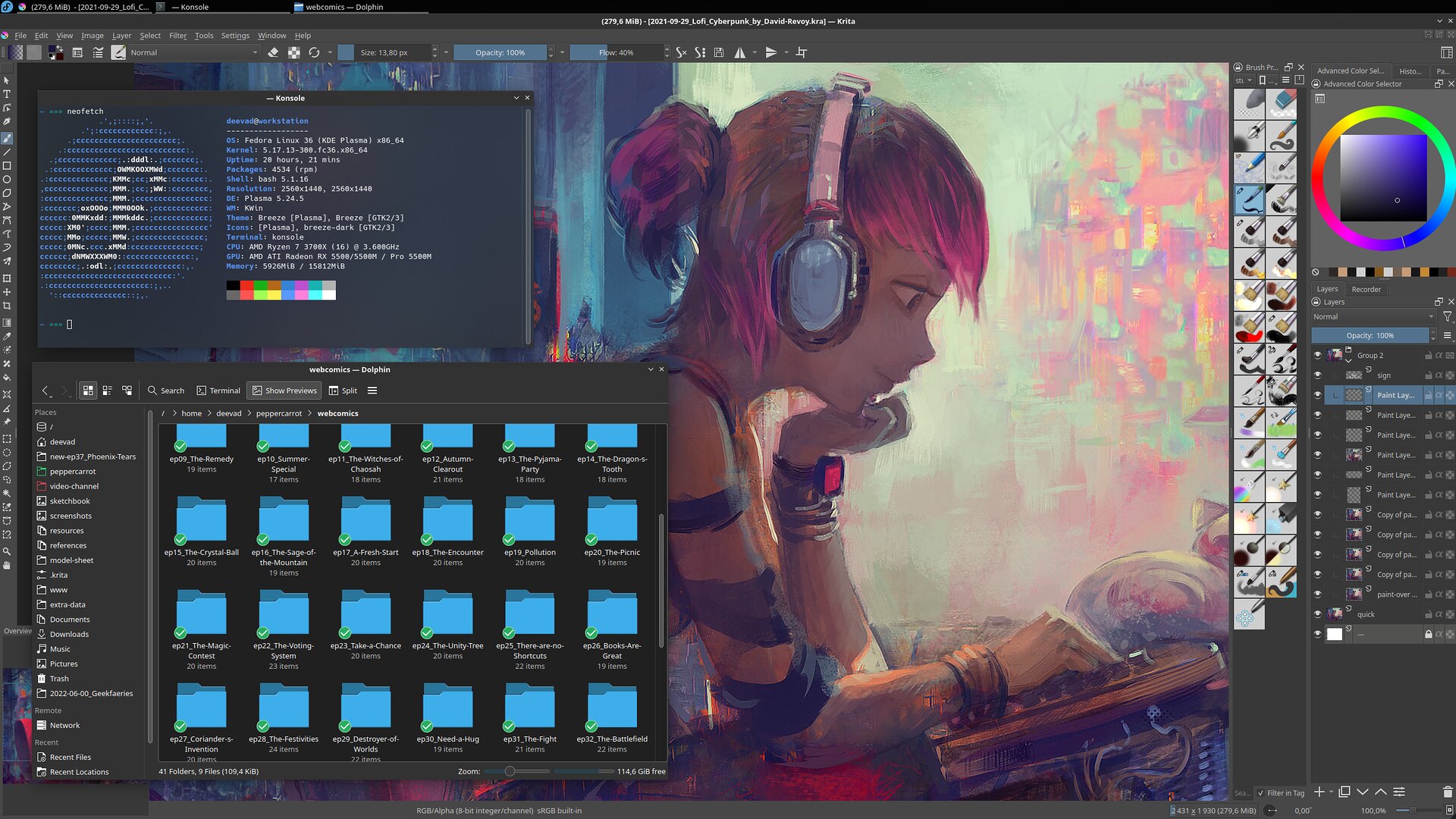
62 comments
Regarding monitor calibration, I have used the Flatpak packaged version of DisplayCAL to calibrate my monitor. You may want to check that version out.
That's a very interesting information Faith, thank you for sharing. 👍 I'll test it with my Pantone Huey Pro and ColorMunkiSmile, it can be a great update for this article later if it works fine.
what an interesting idiom you have introduced me to: https://en.wikipedia.org/wiki/The_Young_Man_and_the_Swallow
OBS studio is also distributed through flathub officially. You may want to check that.
Thank you for the article :3
Fedora has a very nice updating and backup system, clean minimal GNOME environment install with fixed butter-smooth fullscreen window v-sync (^~^) but I've found Firefox picture-in-picture is bugged, and you still need to master nvidia drivers kamasutra :'D
HUION tries making Linux drivers for their tablets now (.deb and .tar.xz packages). Worked fine for me on Mint, 1-click install, connect cable to tablet, reboot - and voilà! \o.o/ it looks & works just the same as it does on Windows.
How do you file manage as an artist on Linux? Manually clone User folder to some another "Backup" drive once a week\month? Or move user Home to another disk and then backup it? How? :3c
Thank you for this very detailed and instructive guide!
I am using Linux Mint for a year now and I have to admit you review makes me considering giving a try to Fedora, but I am still a little bit worried about it, isn't it more dedicated to "advanced" GNU/Linux users? Mint is very easy and smooth, I appreciated that, whether it is to use Krita or daily apps.
What is your experience in terms of easy-of-use with Fedora so far?
I wonder, since you tried quite a few GN/Linux distros during past years, could it be useful to have someday a quick comparison of several distros for people unfamiliar with GNU/Linux, assessing both digital painting features and "daily use"? That would be additional work and you've already done something great here, i'm just throwing the idea.
Great article David,
For me, I’ll stick with Kubuntu and I don’t mind Snap packages. Fedora is secure, stable, and user-friendly, but it feels Fedora is for corporate environments.
was wondering why you chose Fedora over other popular distros. Thanks for the write up.
I am still convinced with my arch setup largely due to rolling release. but I like what I see here. Fedora being my first Linux distro, it's awesome to see it used in a professional environment.
Je suis passé à Linux y a pas trop longtemps (un peu grâce/à cause de vous entre autre ^^), donc mon intervention n'est peut-être pas pertinente. Mais à propos du lentissime Firefox-snap, j'ai suivis les lien ci-dessous, dé-snaper Kubuntu et réinstaller la version ppa de firefox. Et so far, so good! :-)
https://haydenjames.io/remove-snap-ubuntu-22-04-lts/
https://www.kubuntuforums.net/forum/currently-supported-releases/kubuntu-22-04-jammy-jellyfish/post-installation-ax/662347-de-snaping-and-firefox-without-snap
Voilà, si cela peut aider.
Quote: "You'll get a collection of packages frozen for around half a year"
That's not the case for KDE, since Plasma has three releases per year (Gnome has only two), so Plasma will be updated to 5.25 in Fedora 36.
Fedora also updates the kernel and other packages (e.g. pipewire) consistently.
Thank you Peter, that's a great addition for editing the article and add an erratum.
Do you know if there is somwhere I can read about policy or rules about these updates? That would make the part of the article even more accurate. I'll try to search about it (eg. Wikipedia page, or distrowatch).
Ha super, merci du témoignage, Un_Passant,
Alors oui, j'ai bien pensé à dé-Snapifier Ubuntu, mais, à un moment donné, ça montrait simplement que je n'étais en accord profond avec une direction majeure que la distribution prenait. Ca donne donc plus envie de contribuer à redorer leur image. Et puis, pas mal de mes applications ont disparu des paquets Debian. mp3gain est un Snap, micro text editor, un Snap aussi, Chromium (que j'utilise pour mes visios et testé le site), Snap aussi. Les rapports de bugs de Kdenlives: 4 sont sur les Snap, ceux de Krita, idem. Fatigue.
Bref, si en plus Canonical à la main sur l'index des Snap du Snapstore (ce qui peut entrainer les dérives: censure, limiter l'accès d'un concurrent, tapis rouge pour partenariat commerciale) et que je vois toutes les communeautés pourtant basé sur Ubuntu comme Mint, Elementary et Pop_OS se déSnapifier... et bien, ça ne m'encourage pas. Cet article n'est pas sponsorisé, certes, mais je sais que mes recherches (depuis Avril, j'ai passé en revue plein de distro, testé) sont souvent prise au sérieux et interessent aussi ceux sous Mac et Windows qui sont curieux de "comment c'est un système Linux".
C'est pourquoi, j'ai jugé que DéSnapifié du Kubuntu, dans le contexte de mes articles et après onze an de ça, ça fesait pas sérieux!
(mais je valide le 'Do It Yourself' de la chose ;-) )
Hey, oh, the "Reason" top part of the article partially replies to that.
First, I'm focusing mainly on KDE Plasma distro (and not hack, like installing Plasma on top of Mint, Elementary or Pop_OS).
The spectrum of dedicated KDE Plasma distro is not that large, so it removes a lot of distro.
Then I remove all the rolling-update (Manjaro/Arch) for reason it is too bleeding edge for my library and development and video channel.
I do not often live stream, video tutorial, but when I have a small two day budget for it, I hate to get the double punition (1. being punished by the bug itself and have to find a workaround, 2. Having to report the bug and follow yet another one thread/ticket and test the fixes). I can't count the number of mission I missed because of being on a rolling distro. Too bad, I really liked AUR and the Arch Wiki.
What's remaining after that? OpenSuse, Fedora KDE Spin, Debian KDE, and derivative like MxLinux KDE. OpenSuse never was really polished experience for me, Debian often has too old packages (but I studied it carefuly).
So, from my criteria, Fedora KDE was remaining pretty high on my list. I hope it replies to your questions!
Hi Mufeed,
Thanks! Yes, Kubuntu is still a wonderful choice. Fortunately, I don't have the feeling of Fedora being for corporate environment here. But for a long time, I had the feeling the Gnome main version was a test bed for the Red Hat Enterprise Linux, and choices were motivated to experiment things on users. I was really pleased when I read (recently, because I started to plan my switch) that it was run by a council https://docs.fedoraproject.org/en-US/council/ and decision were made by a consensus process. But, I'll see, I have yet to discover the dark part of this distro, culture and gouvernance. It will come with time.
About Displaycal:
1. There is a flatpack for it, so it should work also in Fedora 36: https://flathub.org/apps/details/net.displaycal.DisplayCAL
2. Its not abandoned, there is a community fork https://github.com/RomanHargrave/displaycal (albeit a bit hidden, no binary releases;) , and Florian Höch is still active on the forum.
Ha, thank you for redirecting me to the origin of it; I had no idea where it came from. Interesting.
I tested it at first, but the viewport was only full of green pixel glitch soup. It was pretty broken.
Hi, you probably refer to Gnome on Wayland, and a specific application for backup. Maybe picture-in-picture bug on Wayland?
Yes, about Huion (and now also a couple of other brands), it's been years I'm in touch with them by email trying to convince their marketing department of having a driver for Linux. In short, they want me to review their product on my channel, but I always refused until they had a FLOSS and on Linux driver... Unfortunately, they skip all the 'FLOSS' part and came back with proprietary 'in house' drivers. So I still refuse. I'm not trusting their driver, it's a black box; why they need this full opacity? Does they had telemetry? With Linux (especially X11) being unsecure for all Xinput device (in short, any apps can get all keyboard event anytime) I wouldn't feel comfortable with a proprietary driver on my system for a device like that (that handle keyboard press). I'll wait expert to tell me if the apps communicate with a distant server before advicing it.
About my file management; most of my artworks and work is Free/Libre and distributed; so I have almost all sync on distant server online. For the other parts, I use USB external disk, and a homemade simple bash script (just mainly to save a rsync command line), that mirror my data to the external drive. It quickly update. Sometime, I copy a snapshot on a larger disk, for long term storage. So, I keep this way snapshot each year of last years.
Thank you Flo, yes, the first comment of Faith pointed on this direction. This is a good news, I'll amend the article with it but I'll have to test it first.
It would be great if Florian Höch could update the main DisplayCal website, to replace the Linux version with the Flathub link, and the source with the community fork. This type of information is near to impossible to get without specifically knowing it.
Hi Notus,
You are right, the installer is for example clearly requiring more advanced knowledge than the Mint/Ubuntu installer. It's like a pass test for weird graphic interface, with blue buttons hidden on top-left to 'continue' and blue on blue-background so you can be sure to not see them. Seriously, the Fedora installer is a bad experience, but it does the job. Once the installer issue done, another issue can be the instalation of Nvidia driver with the RPMfusion repository (not my case, but I understand it is a bit more difficult than how Ubuntu/Mint handle the driver for you). It's not more complex than adding a ppa and installating a package; it's trivial 5min work of copy/paste with a good guide, but it can be impressive. Especially when visiting a new territory and be outside the comfort zone. It can feel sketchy.
For pure usage; all I had to do here was 'dnf search package' and 'dnf install package'; or use Discover. So, it was super easy. No package mess or dependency conflict, even with over 4000 package. Installing the printer was a bit easier; the installer was resolving the group/permission for my user to be allowed to print (while on Kubuntu, I had to add that manually), and for the scanner same; I had no issue with permission here also. So, for my setup, it was easier. If you compare my Kubuntu guide to this guide (and add the 'advanced' appendices too) you'll see less workaround and papercuts.
For your second question, yes, doing review and adjusting the info is a lot of work. But maybe if can be collaborative. It is an exellent idea. I'll keep the idea in a corner of my brain and try to think how it can be done. No promise, but why not.
Yes, PiP bug in Gnome on Wayland, it's annoying, but not so much as XFCE Firefox minimizing together with PiP window :'D
I see, well, it's understandable. My guess is that: like a hardware, their software is also little bit copy-paste'ish from Wacom and\or Gaomon, it's a tablet giant on whose shoulders a whole industry was built with hundreds models of tablets\pendisplays under different brands. Windows version of drivers indeed does communicate to update servers in China, but Linux version does not have that module, yet, hmmm, my tinfoil hat starts tingling from these shady activities, what are you up for, Huion-kun, huuuh? (≖.≖)
*makes a rule in firewall for huion drivers, just in case* >;3
Let's hope Huion reconsider to opensource their drivers, because soon Windows 11 User Exodus most likely happen and all millions of machines these users own (together with huion tablets) would need a place to go, and that place should have working drivers...
Oh! Mirroring with copy script to the external drive, very handy, and mobile, nice!
Thank you for your time
Thank you! I've had Fedora for years and Debian before that. I just upgraded to 36 and Krita 5.0.0 included. For whatever reason, I had no scripts. AppImageLauncher solved my problem fast. Now I get 5.0.6 and I have scripts! If only setting up my Huion tablet had been that easy...
Oh, the firewall for the non open-source driver is a good idea!
I'll try to learn how to do it and do an article about it.
Hey, the "whatever reason" is often issue with building/packaging by distro. Krita became so complex and precise to build with all libraries at the right options (including patched libraries instead of waiting the code to reach downstream) that it is near impossible for distribution to do it right. On the Appimage, Krita team can freeze libraries to a version, patch the big Qt framework to solve bug at root, and polish the user experience.
Oh yes, for the Huion tablet; I bought one years ago (you'll find the article on "hardware" tag on the blog). Once the tablet had a Xorg rule; the kcm_wacomtablet module was picking it as a tablet. It couldn't do all buttons, but mapping and a couple of options. You also have the proprieatary driver of Huion now; but I'm affraid it contains telemetry to Huion's server. A comment above suggest creating a firewall rule around the executable to be sure this one doesn't transmit info; that's a cool tip!
Hi! Thanks for such a long explanation and it makes sense. In fact I quickly hopped on to distrowatch with your set of criteria and could not find much luck with KDE focused distro except Suse. However, my hands have burned a lot with rpm based package system distros but with your write up, I am downloading Fedora to test in a virtual environment. Thanks!
I'm a developer, not an artist nor designer, but I really liked your "GNU/Linux Creative Suite" section. There are some programs there I didn't know they existed (and for sure I've needed). Thanks for writing this down!
Would be great to watch your fedora YT review
A really interesting article, thanks for sharing.
Like you, I'm less than happy with the way Canonical is taking Ubuntu (what next, a snap for the terminal emulator?!), and therefore the impact that will have on Ubuntu based distros (like my current Linux Mint Cinnamon Edition).
Interesting that you went with Fedora KDE Spin. That is something I'm seriously considering too, although the 6 monthly update cycle could be bothersome (Fedora LTS I wish was a thing, which updates only every two years just like Ubuntu LTS based distros).
Although how well does Fedora work with Nvidia GPUs? That may be the fly in the ointment for me...
Hey, Thanks! Honnestly, if the quality of Snap package had more testing and effort (and to dream, improved performances), I wouldn't mind that much. Would remain the Canonical as a centralised tenant of the Snapcraft list, but this could have pro and cons: possibility of better moderation and package review for security on the pro, but... possibility of censorship, ban of the store, setup of an algorithm to showcase a product/partner in the con. Well, all in all, if it is worst and not that open, I understand why Mint, Elementary and Pop_OS don't adopt it.
I haven't tested here for NvidiaGPUs; I have an AMD graphic card on the workstation and my laptops have all IntelGPU chipset; so it's true I haven't studied this part. In the past, I had a Nvidia graphic card; and after a fresh install, Fedora was running with Nouveau driver and I had to install the driver from RPMFusion repository (plenty of tutorial with easy copy/paste line was available on the Internet, it was 5min work). After that, the system was really like a driver installed in Mint of Ubuntu. It was just a little less convenient for the install as far as I remember. I imagine it is still the same now.
Thanks! I'll see, someone asked me about a desk/setup review, and about small apps that I like. It can make a fun video.
Hey, Thanks!
The reasons why KDE follows different update policy can be found on Fedora wiki page:
https://fedoraproject.org/wiki/SIGs/KDE/Update_policy
Thank you Julus for this precise source of information. I'll read it carefully and update what is necessary.
Ok, I read it and no need to update then. Maybe I'll add a precision: a major KDE _can_ happen in the life cycle of a Fedora release; but that's the exception and it happens only if the packages have been tested and regression/bugs fixed and everything is super safe. It's most likely to not happen, and be updated for major next Fedora number. So, I'm curious if what Peter predicted will happen; if next KDE Plasma will land on Fedora 36. I can confirm Kernel and Pipewire, but that's ok; it's security fixes, internal plumbing; the sentence I told about software and workflow frozen for 6 month remains true.
Hi, if you're already using rsync for file handling you may want to have a look on backintime. It's a rsync client (with graphical front-end), which allows using multiple profiles. Per profile a separate target, different source folders, exclude list, etc. can be set. I found this a very useful tool, particularly the graphical front-end takes some pain from "desktop users" compared to using plain rsync on a shell.
On Fedora backintime can be installed easily via Discover or:
dnf install backintime-common backintime-plugins backintime-qt
where the latter installs the graphical front-end.
Hey, sure it's a good solution; I used it back in time (pun intended xD) but I don't know; I had issue with incremental backup and requiring a middle man software to browse archive in time. It's for me much easier to get a clone of the whole tree (or more than one, like 5 a year) and proved to be easy and super effective to restore in case of issue; or just to browse them with any file manager.
I should look at it again now; I tested it long time ago, I'm sure the software improved and probably has setup for my usecase (updating a static clone; one that I rename from time to time at root with a timestamp).
I certainly think I'll be migrating away from Linux Mint & Ubuntu based distributions now though. As to what, I'm still undecided. It certainly won't be anything rolling release like Arch / Manjaro etc. I'd rather use my system, than nurse massive daily updates.
Gufw is very easy to use. My personal preference is deny everything except HTTPS useful for when I'm online. You can add profiles for when you work. I rely on email and have another profile with the same HTTPS rule and secure email protocols only. You can set rules for specific internet protocols, might take a bit of time getting used to but is really as uncomplicated as a software firewall can get.
I have used a lower tiered Wacom intuos using Nvidia and Wayland on Fedora and my experience was not that great. For some reason I had two cursors, one was the tablet the other was my touchpad (on laptop). If I wanted to use the tablet I had to disable the touchpad if I wanted to have them both I had to settle with them sometimes contending with each other. Full Disclosure regarding this it was on F34 and there may be changes since then. Just tossing my coin to the well too.
I guess you already noticed that KDE 5.25 update has landed in F36. Out of curiosity had you any issues with the update?
Yes, I can confirm; 5.25.2 runs here. I have the 5.25 new goodies: Meta+W Overview new feature and floating panels. The update was very silent and came without any trouble. if I didn't know about it, I would probably not being able to tell any difference.
Thanks for this amazing article David (specially the tips on the software you're using).
About the upgrade between versions: that presently only works via CLI or thru GNOME's Software app store.
Upgrade thru Discover GUI is however in progress. See:
https://bugs.kde.org/show_bug.cgi?id=446924
Let's all cross fingers and hope it arrives before Fedora 37
Oh, finger crossed too! Thanks for the link to the report.
A few weeks on, are you still enjoying Fedora KDE Spin, David Revoy?
I'm still undecided on Fedora, as the 6 monthly upgrade cycle could be somewhat bothersome!
Hey, still on it, still no pain and super happy about it.
For sure, the real big test will be to check how my environment will behaves with all the packages ( < 4000) on the jump from 36 to 37 this autumn.
Sounds good. I guess the proof will be if you have a painless upgrade from Fedora 36 to Fedora 37.
Alas, a few stumbling blocks for myself trying to get Fedora 36 running on my hardware.
While I have got the Nvidia GPU drivers installed, they don't seem to support OpenCL hardware acceleration, which is what I need for 3D rendering.
Plus for some reason my CPU & GPU fans seem to be running faster on Fedora, rather than on other distros.
Now I could spend ages trying to fix these, but more than likely I'll switch to Kubuntu 22.04 LTS. However I'll certainly use your tips for getting the productivity software installed (albiet tweaked for Kubuntu rather than Fedora). At least I'll not need to worry about major upgrades until Kubuntu 24.04 LTS comes out :-)
The fly in the ointment now, may be Fedora removing H264 GPU video codecs on AMD...
https://www.youtube.com/watch?v=pbJZ7BzoCSU
Yes, I haven't seen the video you linked, I'll watch it later.
But I have been informed about this issue.
It might affect directly old computers that required GPU codec to get enough power to decode specific H264 Codec videos.
As far as I understand, it will not affect watching a video in the browser or using the CPU for decoding (not an issue on modern CPUs), and I think a repo or a workaround will be available quickly after that.
Just a reason more to not use a proprietary format in my workflow, IMO. I use h264 only to encode videos and send them on social/media or youtube. I'll probably have no issue continuing to do this.
Will you be affected by this change?
At the moment it doesn't affect me, as I'm still on Linux Mint. I'm still to transfer to a KDE based distribution, but I'm finding it difficult to chose one which doesn't have issues like snap and advertising in apt (Kubuntu), or has issues with codecs (Fedora).
But definitely a good point about not using proprietary formats.
Oh yes, it's very difficult to find a distro and accept compromises because there is rarely any perfect solution, and also some improve while others regress.
If you make a table with your priorities, you'll find quickly a rational solution about a distro that answers your use case and match your ethic with the less dissonance, workarounds, and tweaks possible. Good luck!
Displaycal has been brought back to life and a python 3 port is done - https://github.com/eoyilmaz/displaycal-py3
How it was the transition to Fedora 37?
Hey! Super smooth. I upgraded one or two days after the release, I wrote a Toot about it; you can read other feedback on the comments: https://framapiaf.org/@davidrevoy/109350743915171500 .
Right now, I'm keeping the system under observation, waiting to find a part, a library, a setup (eg. something that I only monthly use) that could break. Nothing so far after two weeks. I even installed the laptop with it (a Purism 13) to go to the Capitole du Libre and made my painting demo with it. I also upgraded a tablet I have here (a test device, a MsSurfacePro3, something I thought I could draw with "on the go" on Linux but has too much lag and bad stylus/cpu for that), using the Gnome version and Wayland now. It was even easier because it was just a click on the GUI. Needless to say, I'm impressed!
Well, I have given KDE Neon a try out for a couple of weeks.
It seems less "bloated" than Kubuntu, (no snaps, and just the base OS installed by default) however I can honestly see the all too frequent updates to the KDE software to become rather annoying. Plus with it having a "rolling" KDE software on an LTS Ubuntu Base, I can think that there may be issues with updates to KDE at times causing instability...
Maybe KDE Neon is an idea distro for someone developing KDE Software, who needs the latest version of KDE (5.25.6). But for someone using their system for production use? Maybe less so.
Hey Brian,
I think KDE Neon and Fedora KDE Spin are finally very similar in regards of this policy. I admit I was expecting from Fedora a less aggressive update policy for KDE Plasma, and more 'only fixes' for 6 months. I also have the latest (5.26.5) for the worst and for the best. For example, I experienced probably the worst bug in a distro with Dolphin since 2 weeks. I use a lot of drag&drop to copy or move files between two Dolphin windows, and Dolphin was doing many mistakes (eg. not copying the file I d&d but the previous one!). This morning, just before typing this message, I saw 170 updates poping in my queue. On Fedora via Discover, I can't decide to just update Dolphin: it's a 'software upgrade' meta big package with all or nothing. So I applied the upgrade. In a couple of hours, I'll have to connect a Jitsii server to teach a 1h digital painting Krita course to a school remotely, and record the desktop at the same type with OBS, while painting on Krita and recording microphone. I'm aware that with a volume of 'latest' upgrade like that pushed almost every two weeks, with pieces coming sometime daily, my workflow can be impacted on a daily basis. This is an aspect of Fedora that is stressful and very near of a rolling distro for KDE packages, unfortunately. On one side, I appreciate having 1 week after the blog entry of KDE dev the new toys (that I rarely use, to be honest), on another hand each time I have to revisit a workflow I don't do every day I wonder if it will be broken or not by an update. But still, I keep this distro because I don't see any other better option right now, and I haven't yet experienced a big drama update with this risky (IMO) policy. Maybe I'll get used to that and it will become less stressful once I trust it a bit more. So, far, it's only a bit less than a year I'm on F36 and then F37, I felt a little burnt by Dolphin recently and I hope it will not be the type of bug I'll meet often on my way. :-)
David, très grand merci pour toutes ces infos et le temps que tu prends à nous expliquer les choses... J'ai une question en tant qu'artiste digital du dimanche (mais très passionné ;-) : j'aimerais également pour des raisons financières et éthiques passer à du libre et open source , sans y connaître grand chose à la techno et à la manière de résoudre les problèmes liés... J'ai du bon hardware très récent (base AMD et Sapphire) et j'aimerais commencer avec un dual boot Windows / Linux. J'ai pas mal travaillé dans le passé avec Mint et Ubuntu et j'aimerais tester Fedora. Crois-tu une bonne idée pour un 'noob' comme moi de démarrer de cette manière avec Fedora , l'idée étant de migrer peu à peu toutes les applis vers leurs équivalents sur Linux / Fedora. Je souhaite un OS stable sans devoir changer de distro très souvent.
Je te remercie pour ton avis. Excellente continuation et beaucoup de succès. Eric / Bruxelles
Bonjour, c'est un chouette projet, et je dirai qu'il faut suivre sa motivation (pour le meilleur ou pour le pire). J'ai parfois été moi-même super motivé pour certaines distro, et au final, après quelques jours, ça ne me plaisait plus du tout. Faut pas avoir peur au cours d'un changement à essayer, tatonner, et revenir sur ses pas si besoin. C'est rare de prendre une décision totalement mentale et de mettre en execution et de faire un sans faute. Certaines distro vont mettre en confiance et bien tourner sur certaines config; d'autre vont être des cauchemards. Ici, mon utilisation de Fedora (37KDE) évolue; j'adopte petit à petit les Flatpak qui rendent la vie plus facile (et m'évite des bugs sur d'autre variante de paquets) pour l'instant OBS, Kdenlive et BeeRef principalement. Tout n'est pas rose; j'ai des petits bugs et ralentissement dans certaines conditions... je vis avec. :-)
Hey Monsieur Revoy!
Firstly, Thanks for this article! it was awesome and had helped me a lot, I'm leaving ClipStudio Paint (since the last year migration from 1 life payment to subscription "¬¬ ) to use Krita!
The Fedora 37 experience is really great, from a POV of an Ubuntu user (since 12.04 LTS).
Just one fix I've found is MyPaint setup, the URL domain seem to be updated from .org to .app: https://github.com/mypaint/mypaint/issues/1196
Again! Thank you a lot!
Thanks for the feedback and for reporting the issue. 👍
Bonjour Mr Revoy
Je tiens tout d’abord à vous remercier car vous avez fini de me décider à adopter Fedora.
Utilisateur d’Ubuntu depuis la 12.04 je partage entièrement votre avis sur les fameux snap imposés par Canonical qui m’ont bien cassé les pieds. J’ai utilisé l’environnement Mate pendant longtemps mais l’équipe de KDE propose d’excellents logiciels que vous citez et surtout l’indispensable KDE connect. C’est pourquoi j’ai adopté récemment KDE avec Kubuntu 23.04 que j’ai laissé tomber au bout de…2 jours. Je suis actuellement sous Fedora 38 avec Kde et j’en suis ravi.
Je tiens toutefois à apporter une petite précision car moi aussi j’ai besoin de X11 à la place de Wayland pour une application. Si comme moi vous n’avez pas besoin du mot de passe à l’ouverture de votre PC, il y a la possibilité de se connecter directement avec X11 : dans configuration système, écran de connexion (SDDM) en bas à gauche cliquer sur comportement, vous trouverez se connecter automatiquement et là vous pouvez choisir entre X11 et Wayland.
Librement, merci encore pour tout ce que vous faites et partagez.
Merci!
En effet, je ne savais pas comment c'était possible de changer pour X11 sans session login/pass à l'ouverture. Merci pour l'astuce.
Idem ici; j'ai essayé de refaire recement un petit tour sur un laptop par curiosité sous Kubuntu, KDE Neon, Debian KDE... et je suis revenu à Fedora KDE pour la dite machine.
Après, ça m'agace un peu que le KDE spin soit si petit sur le site de Fedora et dans le pied de page. On dirait vraiment que les spins veulent être étouffé et ça ne me rassure guère. ^ ^`
Post a reply
The comments on this article are archived and unfortunately not yet connected to a dedicated post on Mastodon. Feel free to continue the discussion on the social media of your choice. Link to this post:You can also quote my account so I'll get a notification.
(eg. @davidrevoy@framapiaf.org on my Mastodon profile.)